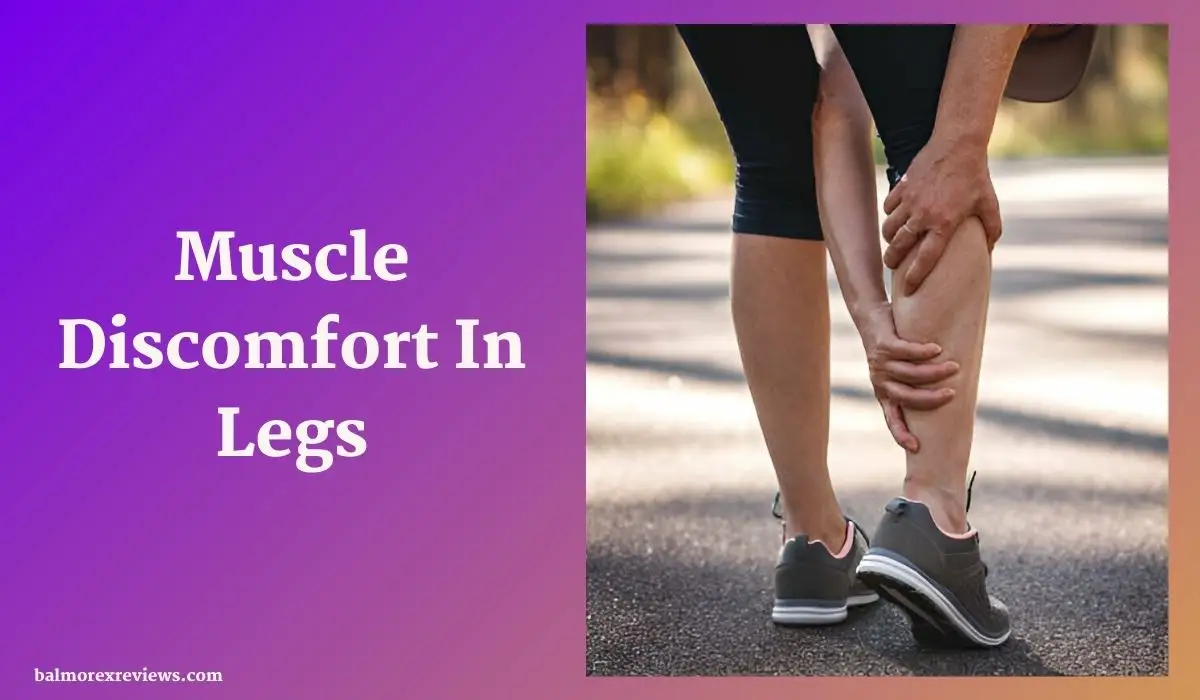How To Get Rid Of Muscle Discomfort In Legs: Tips And Techniques
Explore actionable tips and techniques to alleviate muscle discomfort in your legs. From gentle stretches to soothing massages, discover effective strategies for easing soreness and enhancing leg comfort. Whether you’re an athlete recovering from intense workouts or someone experiencing chronic discomfort, this guide offers practical advice to help you find relief. Improve your leg health and mobility with these expert-recommended methods, designed to target muscle tension and promote overall well-being.

Disclaimer: This article has been generated with the assistance of AI tools. While our research team has fact-checked the content, readers should independently verify information for accuracy and reliability.
Muscle discomfort in the legs can be a frustrating and debilitating experience, whether it’s a nagging soreness or a sudden, sharp cramp. This discomfort can interfere with daily activities, exercise routines, and overall quality of life. Fortunately, some various tips and techniques can help alleviate and prevent muscle discomfort in the legs. In this article, we’ll explore the potential causes, symptoms, and effective strategies to get rid of and avoid this common issue.
Can Muscle Discomfort In Legs Be Prevented?

While muscle discomfort in the legs may not always be entirely preventable, there are steps you can take to minimize the risk. Regular stretching, proper warm-up before exercise, gradually increasing physical activity levels, and maintaining good posture can all help prevent muscle strain and discomfort [1]. By being proactive and taking preventive measures, you can reduce the likelihood of experiencing leg muscle discomfort.
Possible Causes Of Muscle Discomfort In Legs
Muscle discomfort in the legs can have various underlying causes, including:
- Overuse or muscle strain: Engaging in excessive or repetitive physical activities, such as running or weightlifting, can lead to muscle overuse and strain.
- Poor posture: Prolonged standing or sitting with poor posture can put unnecessary strain on the leg muscles, leading to discomfort [2].
- Dehydration: Inadequate fluid intake can cause muscle cramps and discomfort, especially during exercise or in hot environments.
- Nutrient deficiencies: Deficiencies in minerals like potassium, calcium, and magnesium can contribute to muscle discomfort and cramps.
- Underlying medical conditions: Certain medical conditions, such as peripheral artery disease, diabetes, or neurological disorders, can cause leg muscle discomfort or pain.
Symptoms Of Muscle Discomfort In Legs
The symptoms of muscle discomfort in the legs can vary in severity and presentation, but common signs include:
- Muscle cramps or spasms
- Tightness or stiffness
- Soreness or tenderness
- Weakness or fatigue
- Tingling or numbness
How Is Muscle Discomfort In Legs Treated?
The treatment approach for muscle discomfort in the legs depends on the underlying cause. Common treatment options include:
- Rest and recovery: Allowing the affected muscles time to rest and recover can help alleviate discomfort caused by overuse or strain [3].
- Stretching and massage: Gentle stretching and massaging the affected muscles can help improve blood flow and promote healing.
- Heat or cold therapy: Applying heat pads or ice packs to the affected area can help reduce inflammation and alleviate discomfort.
- Over-the-counter medications: Non-steroidal anti-inflammatory drugs (NSAIDs) like ibuprofen or naproxen can help reduce inflammation and pain [4].
- Addressing underlying conditions: If an underlying medical condition causes muscle discomfort, treating that condition may help alleviate the discomfort.
How Do You Get Rid Of Muscle Discomfort In Legs Immediately?
While some cases of muscle discomfort may require time and proper treatment to fully resolve, some techniques can provide immediate relief:
- Gentle stretching: Slowly and gently stretching the affected muscles can help alleviate cramps or tightness [5].
- Massage: Using your hands or a foam roller, gently massage the affected area to improve blood flow and promote relaxation.
- Hydration: Drinking water or electrolyte-rich fluids can help alleviate muscle cramps caused by dehydration.
- Over-the-counter pain relievers: Taking an NSAID like ibuprofen or acetaminophen can provide temporary relief from muscle discomfort.
Tips To Avoid Muscle Discomfort In Legs
Prevention is often the best approach when it comes to muscle discomfort in the legs. Here are some tips to help avoid this issue:
- Warm-up before exercise: Performing gentle warm-up exercises can help prepare your muscles for more strenuous activity and reduce the risk of strain or discomfort.
- Gradually increase activity levels: If you’re starting a new exercise routine or increasing your physical activity, do so gradually to allow your muscles time to adapt.
- Stay hydrated: Drinking plenty of fluids, especially before and during exercise, can help prevent muscle cramps caused by dehydration [6].
- Stretch regularly: Incorporating stretching into your daily routine can help maintain flexibility and prevent muscle tightness or strain [7].
- Wear proper footwear: Choosing shoes that provide adequate support and cushioning can help reduce the strain on your leg muscles during physical activity.
Home Remedies For Muscle Discomfort In Legs
In addition to standard treatments, several home remedies may help alleviate muscle discomfort in the legs:
- Epsom salt baths: Soaking in a warm bath with Epsom salts can help relax muscles and reduce inflammation.
- Magnesium supplements: Increasing your intake of magnesium through supplements or magnesium-rich foods can help prevent muscle cramps and discomfort.
- Essential oils: Applying essential oils like peppermint, lavender, or eucalyptus to the affected area can provide a cooling or warming sensation and promote relaxation.
- Compression: Wearing compression socks or bandages can help improve blood flow and reduce muscle discomfort.
When Should You See A Doctor?
While muscle discomfort in the legs is often temporary and can be managed with self-care techniques, there are situations where seeking medical attention is advisable:
- Severe or persistent pain: If the discomfort is severe, worsening, or persists for more than a few days, it’s important to consult a healthcare professional.
- Swelling or redness: If the affected area is swollen or red, it could be a sign of a more serious condition, such as a blood clot or infection.
- Numbness or tingling: Persistent numbness or tingling in the legs can be a symptom of a neurological issue and should be evaluated by a doctor.
- Underlying medical conditions: If you have a pre-existing medical condition that could be contributing to muscle discomfort, it’s important to discuss it with your healthcare provider.
Takeaway
Muscle discomfort in the legs can be a frustrating and disruptive issue, but by understanding the potential causes, and symptoms, and employing the appropriate tips and techniques, you can find relief and prevent future occurrences. Whether it’s through preventive measures, immediate relief techniques, or seeking professional medical advice when necessary, taking proactive steps can help you manage and overcome this common problem.
References
[1] https://www.health.harvard.edu/a_to_z/muscle-strain-a-to-z
[2] https://doi.org/10.3390/nu13030794
[3] https://medlineplus.gov/ency/article/003182.htm
[4] https://www.healthdirect.gov.au/leg-pain
[5] https://www.betterhealth.vic.gov.au/health/conditionsandtreatments/feet-problems-and-treatments
[6]https://www.arthritisaustralia.com.au/images/stories/documents/booklets/at%20home%20with%20arthritis%20simple%20steps%20for%20managing%20in%20the%20home%20booklet.pdf
[7] https://painhealth.csse.uwa.edu.au/pain-management/
Natalie Smith
Natalie Smith is a highly respected Osteopath with over 15 years of experience in treating a wide range of musculoskeletal conditions. She graduated from the British School of Osteopathy with a Master’s degree in Osteopathic Medicine and is a registered member of the General Osteopathic Council. Natalie’s expertise spans the diagnosis and treatment of issues affecting the muscles, bones, joints, and connective tissues. She utilizes a holistic, patient-centered approach, combining manual techniques such as spinal manipulation, soft tissue massage, and joint mobilization to alleviate pain and restore optimal function. Passionate about educating her patients, Natalie frequently speaks at local health workshops and has authored articles on osteopathic care for several respected medical journals. Her commitment to ongoing professional development ensures she remains at the forefront of the latest advancements in the field of osteopathy.
